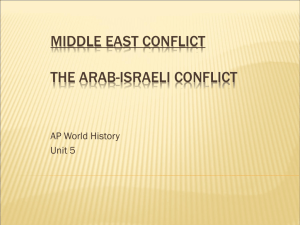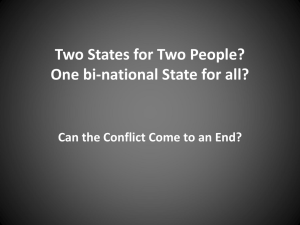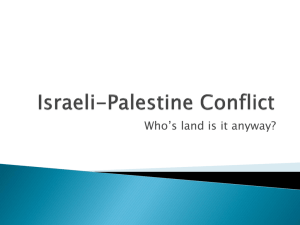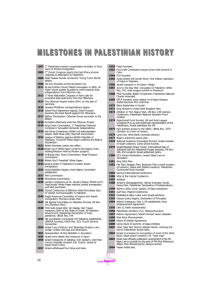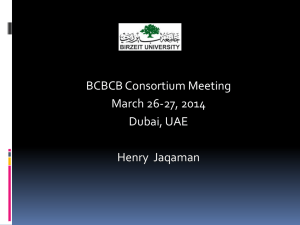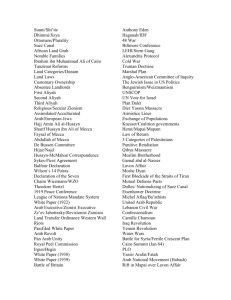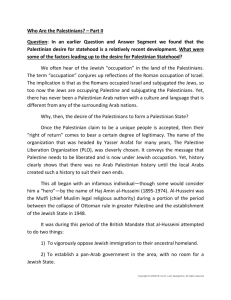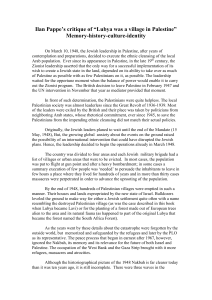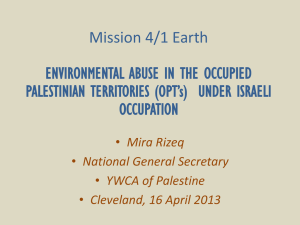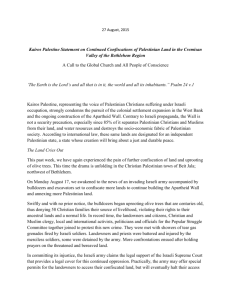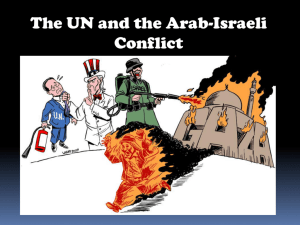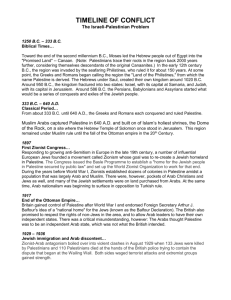Land Politics Israel-Palestine Background of Land Situation
advertisement
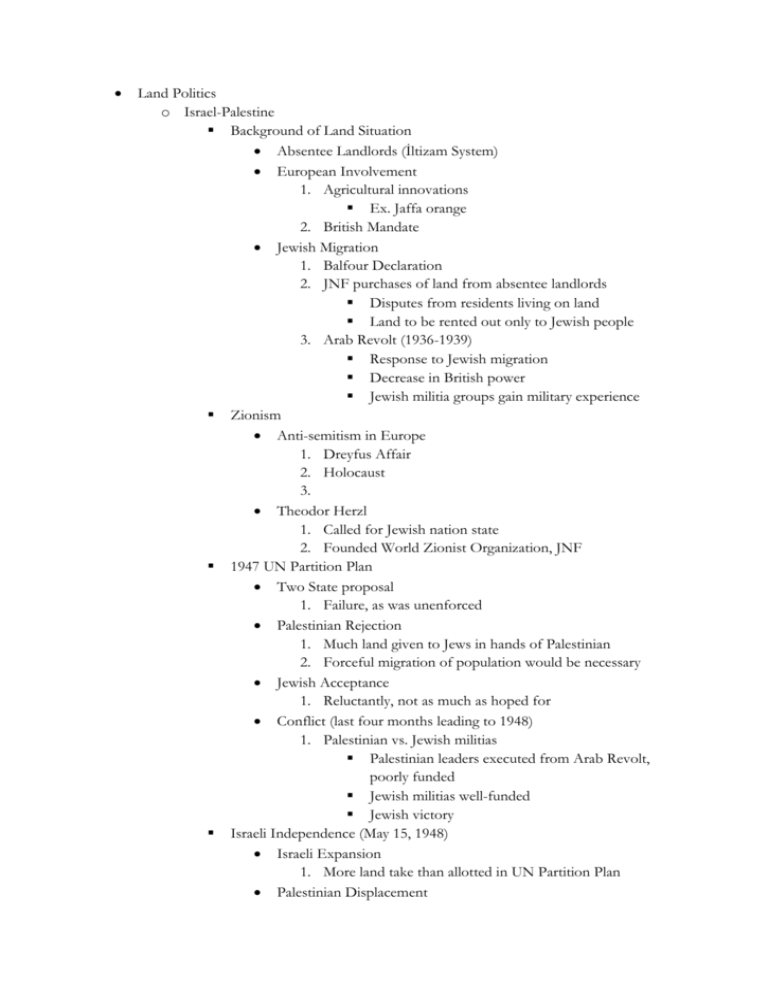
Land Politics o Israel-Palestine Background of Land Situation Absentee Landlords (İltizam System) European Involvement 1. Agricultural innovations Ex. Jaffa orange 2. British Mandate Jewish Migration 1. Balfour Declaration 2. JNF purchases of land from absentee landlords Disputes from residents living on land Land to be rented out only to Jewish people 3. Arab Revolt (1936-1939) Response to Jewish migration Decrease in British power Jewish militia groups gain military experience Zionism Anti-semitism in Europe 1. Dreyfus Affair 2. Holocaust 3. Theodor Herzl 1. Called for Jewish nation state 2. Founded World Zionist Organization, JNF 1947 UN Partition Plan Two State proposal 1. Failure, as was unenforced Palestinian Rejection 1. Much land given to Jews in hands of Palestinian 2. Forceful migration of population would be necessary Jewish Acceptance 1. Reluctantly, not as much as hoped for Conflict (last four months leading to 1948) 1. Palestinian vs. Jewish militias Palestinian leaders executed from Arab Revolt, poorly funded Jewish militias well-funded Jewish victory Israeli Independence (May 15, 1948) Israeli Expansion 1. More land take than allotted in UN Partition Plan Palestinian Displacement 1. 70% displaced 2. Migrated to Neighboring Arab States West Bank or Gaza Strip 3. Refugee Problem Neighboring states refusal to give citizenship to Palestinians (except Jordan) Didn’t want to resolve issue Wanted eventual return Wars 1. 1948 War 2. 1956 War British, French, Israeli Alliance Sinai invasion 3. 1967 War 6 day war Pre-emptive attack on perceived Arab threat Results Occupation of Sinai Acquisition of Gholan Heights from Syria Increased Israeli expansion in Occupied Territories 4. 1973 War Egypt and Syria attack (Sadat in power) Results Camp David Accords o Return of Sinai o Peace with Egypt (out of the game) Intifadas 1. First 1987 PLO leadership out of country, grassroots Uprising against conditions, repression (?) Israeli response brutal, shift in int’l. Public opinion (Itzak Rabim’s comment) Israeli support for religious groups in Palestine 2. Second 2000 Response to Sharon’s trip to Al-Aqsa Shift to Islamic dialogue Peace/Resolution Processes 1. Madrid Conference 1991 US pushed for it, Israel had conditions for participation No official PLO participation, side negotiations with Arafat Palestinin Independence not considered 2. Camp David Egypt recognizes Israel Israeli withdrawal from Sinai 3. Oslo I (Arafat signs out of weakness) PLO recognition of Israel Arafat allowed to return Important issues not adressed Palestinian Independence Refugee Problem Jerusalem Question Settlements Issue 4. Oslo II (Arafat signs out of weakness) Tiered system of authority to Palestinian territories Few areas given Palestinian civic and security control Some areas given Palestinina civic but not securtiy control Most areas remained under Israeli control 5. Barak Offer 2000 South Lebanon, 95% (?) of W. Bank to be returned Fine print proved to be worse than Oslo II Checkpoint controls, settlements, etc. Hurdles to Peace 1. Refugees 5 million 2. Settlements Rooted in Zionism Started after 1967 War 3. Jerusalem 4. Borders o Egypt Legacy of Mehmet Ali Paşa Sought to distinguish his province from Istanbul Development of powerful land-owners Urabi Revolt Demands for participation in government Peasants British Control Suez Canal 1869 Wafd Group of Land-owners Requested Independence from Britain 1. Rejected Revolt 1919 Independence 1922 Free Officers Coup 1952 Against weak government Nasser comes to power Nasser’s government Anti-Imperialist Sought Western Modernity Social and Land reform 1. Health care 2. Education 3. Restrictions on quantity of land Non-alignment 1. Cold War No help from West, got aid from Eastern Bloc Aswan High Dam Support for Palestine 1. Wars 1956 War increased Nasser’s popularity 1967 War Sinai Fiasco Bad for Nasser’s image Anwar Sadat Closer relations sought with West Camp David 1. Peace With Israel in exchange for withdrawal 2. Outside Influences o Imperial Struggles Ottoman Empire Millet System Legacy 1. Separation of ethno-religious groups 2. Loyalty to institutions of millet group 3. Elites of millet derived their position from sultan Decline of Empire 1. Rise of nationalisms 2. Emphasis of Turkishness during Tanzimat 3. In turn, other nationalisms (mesela Arab) German Imperial Ambitions Ottoman-German Relations 1. Influence over sultan 2. Railroad from İstanbul to Baghdad British Empire Trade Route to India 1. Suez Canal between Egypt and Palestine 2. Focus of political attention to region surrounding Suez 3. Signed treaties with tribes along Red Sea for safe passage World War I and Results 1. Fostered Arab Revolts against Ottomans 2. Promised Hashemite family (Sharif Hussein) a state Hashemites given Mecca and Medina Saudis take Mecca and Medina, with help of Wahabi Ikhwan Mandate System System supposedly for regions not “ready” for selfrule British Mandate of Palestine (Palestine and Transjordan) 1. Jordan goes to Hashemite son Abdullah Mandate of Iraq 1. Iraq given to Faisal French Mandate System 1. Lebanon Sectarian government established (by French, right?) Maronite Christians established as dominant group 2. Syria Faisal went to Damascus first French took control Oil Politics o Companies established deals with rulers to exploit oil resources o Rentier States- States that sell a resource and establish a state apparatus which they use to repress their populations Saudi Arabia Deal with Americans 1. Aramco (1933) Royalties given to Saudi family 2. Ikhwan given authority to turn blind eye to Aramco’s activities Jim Crowe type system evolved 1. Laborers treated poorly 2. Agitators handed over to gov., executed Iraq Deal with British 1925 1. Turkish Petroleum Company (Iraq Petroleum Company) Deal with Faisal Fixed royalty given Patronage Network 1. Loyalties formed, as government not popular Ethno-religious Reminiscent of Millet system 2. Development of Land-owners Gained power of their own Pre-Revolutionary Iran Deal With British 1. Anglo-Persian Oil Company Made with Qajar Dynasty Gave virtual control of domestic politics to British Rise of the Shah 1. Shift in alliance to USA 2. 1921 Coup Reza “Pahlavi” Khan takes power 3. Attempt to end foreign influence Anglo-Persian Oil Company untouchable Development of Land-owners 1. Benefit from peasantry and workers Little power to workers and peasants Militarization of Politics
